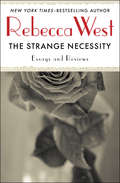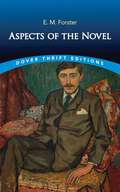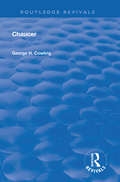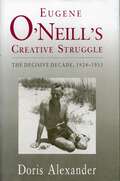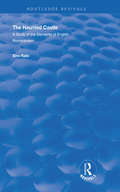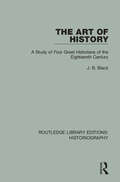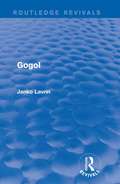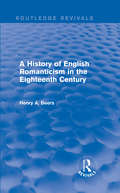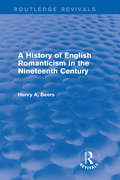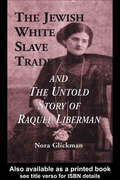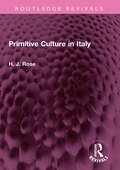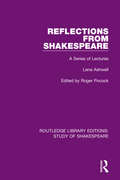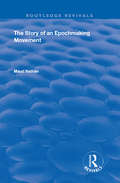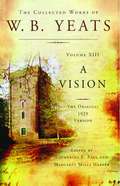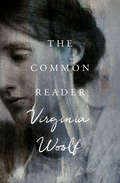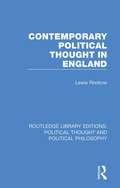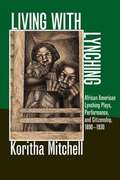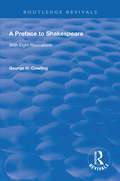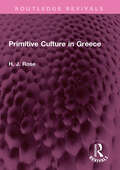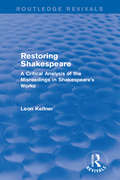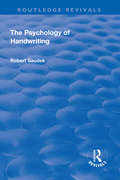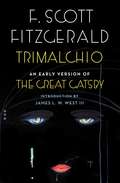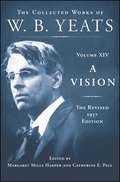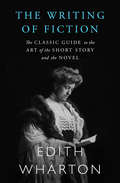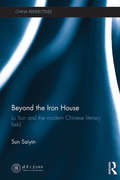- Table View
- List View
The Strange Necessity: Essays and Reviews (Virago Modern Classics Ser. #2313)
by Rebecca WestIn this intellectually challenging collection of literary criticism, Rebecca West undertakes the question of art&’s value, examining the works of her contemporaries and their places in history &“The Strange Necessity,&” one of the twelve essays collected here and first published in 1928, anchors West&’s quest to understand why art matters and how aesthetics of every caliber can not only inspire but reveal the author&’s inner world. Whether juxtaposing Ulysses&’s prose with Pavlov&’s research, or comparing Sinclair Lewis with actress and pianist Yvonne Printemps, West finds that a satisfying emotion overrides an artistic work&’s form. Her intricately crafted essays reveal her experience in the literary circles of the twenties and thirties and the important role this question played in her own writing. West&’s keenly observed criticism offers invaluable insight not only into her work but into her impressions of early twentieth century literature.
Aspects of the Novel (Dover Thrift Editions: Literary Collections)
by E. M. ForsterE. M. Forster, one of England’s most distinguished writers, delivered a series of lectures at Trinity College in 1927. The lectures were compiled in a collection of literary essays, Aspects of the Novel. Forster shares what he believes are the seven important aspects of fiction: story, people, plot, fantasy, prophecy, pattern, and rhythm. He uses literary examples to make his points, including Jane Austen, Charles Dickens, and Marcel Proust, and his commentary is engaging, witty, and conversational. This is not a how-to guide to novel writing but rather an exploration of the elements that make a novel successful.
Chaucer (Routledge Revivals)
by George H. CowlingFirst Published in 1927, this volume provides a discourse on both the literary works of Chaucer, as well as Chaucer as a person, considering his mythology, and the various roles he fulfilled throughout his life.
Eugene O'Neill's Creative Struggle: The Decisive Decade, 1924–1933
by Doris AlexanderIn Eugene O'Neill's Creative Struggle, Doris Alexander gives us a new kind of inside biography that begins where the others leave off. It follows O'Neill through the door into his writing room to give a blow-by-blow account of how he fought out in his plays his great life battles—love against hate, doubt against belief, life against death—to an ever-expanding understanding. It presents a new kind of criticism, showing how O'Neill's most intimate struggles worked their way to resolution through the drama of his plays. Alexander reveals that he was engineering his own consciousness through his plays and solving his life problems—while the tone, imagery, and richness of the plays all came out of the nexus of memories summoned up by the urgency of the problems he faced in them. By the way of O'Neill, this study moves toward a theory of the impulse that sets off a writer's creativity, and a theory of how that impulse acts to shape a work, not only in a dramatist like O'Neill but also in the case of writers in other mediums, and even of painters and composers. The study begins with Desire Under the Elms because that play's plot was consolidated by a dream that opened up the transfixing grief that precipitated the play for O'Neill, and it ends with Days Without End when he had resolved his major emotional-philosophical struggle and created within himself the voice of his final great plays. Since the analysis brings to bear on the plays all of his conscious decisions, ideas, theories, as well as the life-and-death struggles motivating them, documenting even the final creative changes made during rehearsals, this book provides a definitive account of the nine plays analyzed in detail (Desire Under the Elms, Marco Millions, The Great God Brown, Lazarus Laughed, Strange Interlude, Dynamo, Mourning Becomes Electra, Ah, Wilderness!, and Days Without End, with additional analysis of plays written before and after.
The Haunted Castle: A Study of the Elements of English Romanticism (Routledge Revivals)
by Eino RailoPublished in 1927: The purpose of the present work is consequently to serve as a guide to English horror-romanticism and by presenting the chief materials used by it and grouping them according to the various themes employed, to show how the main romantic movement that began at the turn of the century and is represented in all shorter expositions of the subject as a suddenly bursting wave, as a kid of spontaneous revolution, is in all essentials the outcome of an organic development with widely spread roots that penetrate deep into the past.
The Art of History: A Study of Four Great Historians of the Eighteenth Century (Routledge Library Editions: Historiography #4)
by J. B. BlackThe first important scholarly consideration of Enlightenment historiography of the twentieth century, this book, originally published in 1926, critically examines the ideas of Voltaire, Hume, Robertston and Gibbon with respect to the theory and practice of historiography. The substantial introduction outlines the main differences between the ideals of these literary-philosophical schools and those which prevailed among historians in the early 20th century. The author argues that history can never be devoid of philosphical and literary interest, and that if it concerns itself merely with the stablishment of fact, will be a discipline of "contracting horizons".
Gogol: 1852 (Routledge Revivals #No. 56)
by Janko LavrinThis book, first published in 1926, aimed to introduce to English readers to a great and complex foreign writer in as simple terms as possible. As this was the first extensive study of Gogol in English, the author chiefly considered the general characteristics of the man and his work. This book will be of interest to students of literature.
A History of English Romanticism in the Eighteenth Century (Routledge Revivals)
by Henry A. BeersFirst published in 1926, this title presents the great artistic and literary innovations of the Romantic movement according to an often overlooked and unacknowledged definition of ‘Romanticism’, which is of particular relevance in the consideration of the English Romantic spirit: pertaining to the style of the Christian and popular literature of the Middle Ages.
A History of English Romanticism in the Nineteenth Century (Routledge Revivals)
by Henry A. BeersA History of English Romanticism in the Nineteenth Century, first published in 1926, presents the great artistic and literary innovations of the Romantic movement according to an often overlooked and unacknowledged definition of ‘Romanticism’, which is of particular relevance in the consideration of the English Romantic spirit: pertaining to the style of the Christian and popular literature of the Middle Ages. The author recapitulates the key contributions of English poets – including Scott, Coleridge and Keats - in light of their recovery of certain themes and leitmotifs that clearly distinguish the Romantic style. In addition, the development of the Romantic movement in France and Germany is given some attention, and the specific tendencies of their respective approaches is considered in relation to England. The emergence of the Pre-Raphaelites is investigated, and a tentative evaluation of the progress of English Romanticism in the nineteenth century is offered.
The Jewish White Slave Trade and the Untold Story of Raquel Liberman
by Nora GlickmanDescribes the prostitution industry form Poland to Argentina from the 1880s to the 1930s. The text follows the life and career of Raquel Liberman, a Polish Jewish prostitute and victim of the white slave trade.
Primitive Culture in Italy (Routledge Revivals)
by H. J. RoseFirst published in 1926, Primitive Culture in Italy intends to determine to what extent there survived, in the ancient civilization with which it deals, any characteristic features of savage life and thought. The primitive man provides an ideal beginning to study the long upward progress of humanity. This book is not for the specialist, but for the general reader who wishes to know something of the beginnings of a great and notable civilization, the effects of which are still to be seen in our modern culture.
Reflections From Shakespeare: A Series of Lectures (Routledge Library Editions: Study of Shakespeare)
by Lena AshwellOriginally published in 1926, this title was edited from a series of lectures the author gave to raise money for her theatre group the Lena Ashwell Players. Through her work as a producer the author gained a deeper knowledge of a number of Shakespeare’s plays and in order to support her work gave a number of lectures on "Women in Shakespeare". This title was perhaps the first book by a woman of the profession, appealing to the public for a larger and deeper understanding of Shakespeare: the man, his life, and that group of tragedies in which he fathomed Hell, then scaled the Heavens.
The Story of an Epoch Making Movement (Routledge Revivals)
by Maud NathanPublished in 1926: The author tells the story of the Consumers’ League from the genesis of the idea through the days of its development to its present days of power.
The Collected Works of W.B. Yeats Volume XIII: The Original 1925 Version
by Margaret Mills Harper Catherine E. Paul William Butler YeatsThe Collected Works of W. B. Yeats, Volume XIII: A Vision is part of a fourteen-volume series under the general editorship of eminent Yeats scholar George Bornstein and formerly the late Richard J. Finneran and George Mills Harper. One of the strangest works of literary modernism, A Vision is Yeats's greatest occult work. Edited by Yeats scholars Catherine E. Paul and Margaret Mills Harper, the volume presents the "system" of philosophy, psychology, history, and the life of the soul that Yeats and his wife George (née Hyde Lees) received and created by means of mediumistic experiments from 1917 through the early 1920s. Yeats obsessively revised the book, and the revised 1937 version is much more widely available than its predecessor. The original 1925 version of A Vision, poetic, unpolished, masked in fiction, and close to the excitement of the automatic writing that the Yeatses believed to be its supernatural origin, is presented here in a scholarly edition for the first time. The text, minimally corrected to retain the sense of the original, is extensively annotated, with particular attention paid to the relationship between the published book and its complex genetic materials. Indispensable to an understanding of the poet's late work and entrancing on its own merit, A Vision aims to be, all at once, a work of theoretical history, an esoteric philosophy, an aesthetic symbology, a psychological schema, and a sacred book. It is as difficult as it is essential reading for any student of Yeats.
The Common Reader: First Series, Annotated Edition (The Common Reader #1)
by Virginia WoolfA collection of essays from the acclaimed author of Mrs. Dalloway on such subjects as Jane Austen, Geoffrey Chaucer, and her own literary philosophy. A good essay must have this permanent quality about it; it must draw its curtain round us, but it must be a curtain that shuts us in not out. Not written for scholars or critics, these essays are a collection of Virginia Woolf&’s everyday thoughts about literature and the world—and the art of reading for pleasure. That many of them previously appeared in such publications as the Nation, Vogue, and the Yale Review points to their widespread appeal. Still, her brilliant powers of observation and insatiable curiosity shine through . . . &“After all, Mrs. Woolf is no common reader, try as she may to be one. Her powers of coordination and logical inference are altogether too strong and capable. No common reader would kick the over-praised Robinson Crusoe overboard to float in seas of adolescent adoration for Moll Flanders, as she does. It would take an uncommon common reader to discourse as pithily on Elizabethan drama or the furiously literary Duchess of Newcastle. No idle peruser of the printed page would meditate so beautifully on Greek letters. And when we come to those essays, &‘Modern Fiction&’ and &‘How It Strikes a Contemporary,&’ a note that is altogether professional and the result of intensive study and theorizing is to be discerned.&” —The New York Times &“Woolf&’s provocative collection of essays, reviews and flights of literary imagination assesses both the famous and the obscure.&” —The Times (London)
Contemporary Political Thought in England (Routledge Library Editions: Political Thought and Political Philosophy #50)
by Lewis RockowFirst published in 1925. This book is a brief analysis of the historical relation of contemporary writers to their immediate predecessors. The author attempts to further a comprehensive summary of certain selected writers, with a criticism of their ideas, while in the last chapter an attempt is made at synthesis. Among those whose work is examined are Ramsay MacDonald, Bertrand Russell, Harold Laski, the Pauls, Hobhouse, Bryce, G. D. H. Cole, Norman Angell, etc. This title will be of great interest to students of politics, philosophy and history.
Living with Lynching: African American Lynching Plays, Performance, and Citizenship, 1890-1930
by Koritha MitchellLiving with Lynching: African American Lynching Plays, Performance, and Citizenship, 1890-1930 demonstrates that popular lynching plays were mechanisms through which African American communities survived actual and photographic mob violence. Often available in periodicals, lynching plays were read aloud or acted out by black church members, schoolchildren, and families. Koritha Mitchell shows that African Americans performed and read the scripts in community settings to certify to each other that lynch victims were not the isolated brutes that dominant discourses made them out to be. Instead, the play scripts often described victims as honorable heads of household being torn from model domestic units by white violence. In closely analyzing the political and spiritual uses of black theatre during the Progressive Era, Mitchell demonstrates that audiences were shown affective ties in black families, a subject often erased in mainstream images of African Americans. Examining lynching plays as archival texts that embody and reflect broad networks of sociocultural activism and exchange in the lives of black Americans, Mitchell finds that audiences were rehearsing and improvising new ways of enduring in the face of widespread racial terrorism. Images of the black soldier, lawyer, mother, and wife helped readers assure each other that they were upstanding individuals who deserved the right to participate in national culture and politics. These powerful community coping efforts helped African Americans band together and withstand the nation's rejection of them as viable citizens.
A Preface to Shakespeare: WITH EIGHT ILLUSTRATIONS (Routledge Revivals)
by George. H. CowlingPublished in 1908, this book considers the work of William Shakespeare. Providing notes and commentaries on some of his poems and plays, as well as context from English history, and analysis from his contemporaries and successors, Jonson, Beaumont, Fletcher and Massinger, this book will be an interesting read for those interested in his work.
Primitive Culture in Greece (Routledge Revivals)
by H. J. RoseFirst published in 1925, Primitive Culture in Greece dispassionately reviews the claim that the Greeks were ‘heathen’ and asks how much of the savage ancestry was left in the classical Greek. In doing so it traces a historical continuity from the barbaric invasions of Greece to its later emergence of a classical culture. It is not written merely for the specialist, and assumes no technical knowledge, but simply an interest in one of the most remarkable civilizations of the world.
Restoring Shakespeare: A Critical Analysis of the Misreadings in Shakespeare's Works (Routledge Revivals)
by Leon KellnerThe genius of Shakespeare is not always accessible or easily understandable to readers and audiences. Leon Kellner points out that sometimes Shakespeare’s languages does not make sense at all but this is not necessarily because his metaphors are too complex. Rather, the printing of his works is often filled with errors. Originally published in 1925, Kellner’s work explores the reasons and potential mistakes which may account for the unintelligible passages in Shakespeare such as handwriting, abbreviations, and the confusing of pronouns. This title will be of interest to students of English Literature and Linguistics.
Revival: The Psychology of Handwriting (Routledge Revivals)
by Robert SaudekGraphology, in English and American manuals of handwriting, stands in the relation with all other pseudo-sciences, founded on half truths and wrought with superstition and amateur fads, compared to modern science. In this book, the author attempts to put before the English public the fundamental principles, methods and laws of scientific graphology. Contents: common objections to graphology and their refutation; history of graphology; physiology and psychology of writing; random test of the correctness of methods explained; practical hints for drawing up of graphological analyses; specimens of analysis.
Trimalchio: An Early Version of The Great Gatsby (The\cambridge Edition Of The Works Of F. Scott Fitzgerald Ser.)
by F. Scott Fitzgerald"Reading F. Scott Fitzgerald's Trimalchio, an early and complete version of The Great Gatsby, is like listening to a familiar musical composition played in a different key and with an alternate bridge passage... There is a tradition in Fitzgerald studies that The Great Gatsby became a masterpiece in revision. This judgment is correct. Fitzgerald improved the novel in galleys; The Great Gatsby is a better novel than Trimalchilo. But Trimalchilo is a remarkable achievement, and different enough from Gatsby to merit consideration on its own. Trimalchilois a direct and straightforward narration of the story of Jay Gatsby, NIck Carraway, Jordan Baker, Tom and Daisy Buchanan, and Myrtle and George Wilson. The handling of plot details is sure-handed; the writing is graceful and confident. Trimalchilowill provide readers with new understanding of F. Scott Fitzgerald's working methods, fresh insight into his characters, and renewed appreciation of his genius." From the introduction.
A Vision: The Collected Works of W.B. Yeats Volume XIV
by William Butler Yeats Catherine E. Paul Margaret Mills HarperA new annotated edition of Yeats's indispensable, lifelong work of philosophy--a meditation on the connections between the imagination, history, and the metaphysical--this volume reveals the poet's greatest thoughts on the occult.First published in 1925, and then substantially revised by the author in 1937, A Vision is a unique work of literary modernism, and revelatory guide to Yeats's own poetry and thinking. Indispensable to an understanding of the poet's late work, and entrancing on its own merit, the book presents the "system" of philosophy, psychology, history, and the life of the soul that Yeats and his wife, George, received and created by means of mediumistic experiments from 1917 through the early 1920s. Yeats obsessively revised the original book that he wrote in 1925, and the 1937 version is the definitive version of what Yeats wanted to say. Now, presented in a scholarly edition for the first time by Yeats scholars Margaret Mills Harper and Catherine E. Paul, the 1937 version of A Vision is an important, essential literary resource and a must-have for all serious readers of Yeats.
The Writing of Fiction: The Classic Guide to the Art of the Short Story and the Novel (The\collected Works Of Edith Wharton)
by Edith WhartonEssays on the craft of fiction writing from the first woman to win the Pulitzer Prize, for her novel The Age of Innocence.In The Writing of Fiction,Edith Wharton, a prolific writer and one of the twentieth century&’s greatest authors, shares her thoughts on fiction writing, devoting individual chapters to short stories and novels. She stresses the importance of writers putting thought into how they build their story, from selecting subject matter and fashioning characters to crafting situations and settings. She explores the history of modern fiction and the contributions of Honoré de Balzac and Stendhal. She even examines the difference between literary and commercial fiction, as well as the work of Marcel Proust.Although Wharton passed away in 1937, her advice here endures and is bound to inspire writers for ages to come. &“In The Writing of Fiction Edith Wharton gives us not only a period-appropriate glimpse into the mind of an exceptionally creative writer but also an appreciation for the thoughtfulness and discipline she brought to her craft. We are fortunate she was willing to share her observations.&” —Ralph White, author of Litchfield
Beyond the Iron House: Lu Xun and the Modern Chinese Literary Field (China Perspectives)
by Saiyin SunBeyond the Iron House is a critical study of a crucial period of life and work of the modern Chinese writer Lu Xun. Through thorough research into historical materials and archives, the author demonstrates that Lu Xun was recognized in the literary field much later than has hitherto been argued. Neither the appearance of "Kuangren riji" (Diary of a madman) in 1918 nor the publication of Nahan (Outcry) in 1923 had catapulted the author into nationwide prominence; in comparison with his contemporaries, neither was his literary work as original and unique as many have claimed, nor were his thoughts and ideas as popular and influential as many have believed; like many other agents in the literary field, Lu Xun was actively involved in power struggles over what was at stake in the field; Lu Xun was later built into an iconic figure and the blind worship of him hindered a better and more authentic understanding of many other modern writers and intellectuals such as Gao Changhong and Zhou Zuoren, whose complex relationships with Lu Xun are fully explored and analysed in the book.
